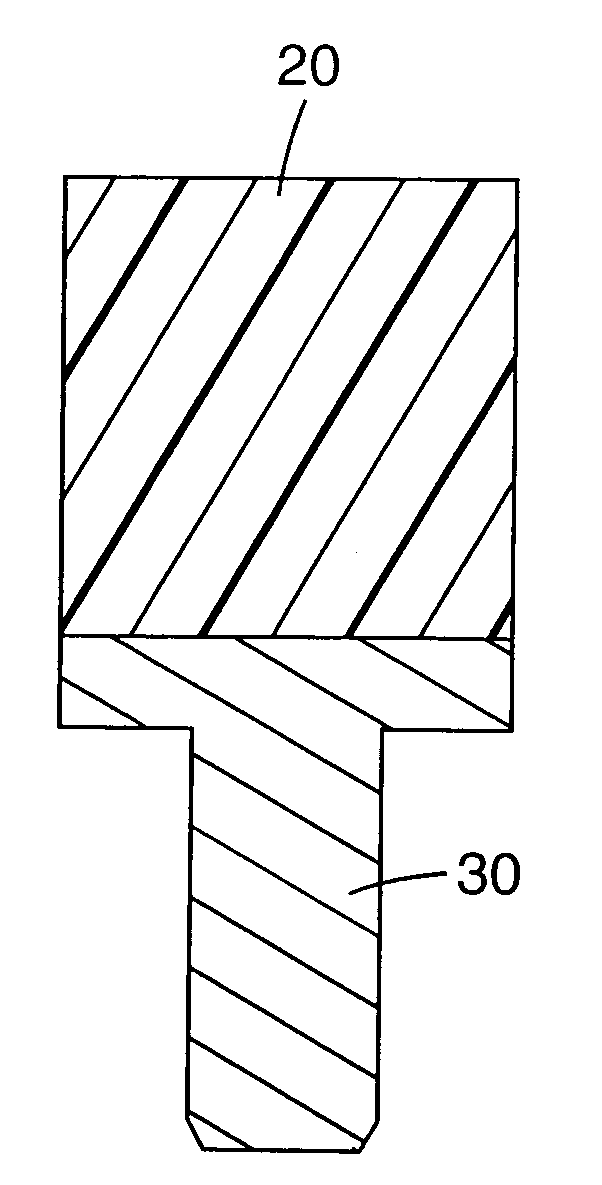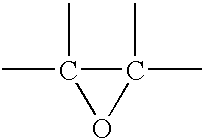Dental mill blanks
- Summary
- Abstract
- Description
- Claims
- Application Information
AI Technical Summary
Benefits of technology
Problems solved by technology
Method used
Image
Examples
preparatory example 1
[0097]A light curable resin was compounded by dissolving and mixing the following constituents:[0098]0.01 pbw Ethyl 4-dimethylaminobenzoate (EDMAB)[0099]0.0017 pbw camphorquinone (CPQ)[0100]0.01 pbw 2-(2′-Hydroxy-5′-methylphenyl)Benzotriazole (“Tinuvin-P”; Ciba-Geigy Corp.; Hawthorne, N.Y.)[0101]0.006 pbw Diphenyl Iodonium Hexafluorophosphate[0102]0.4862 pbw 2,2-bis[4-(2-hydroxy-3-methacryloyloxy-propoxy)phenyl]propane (Bis-GMA)[0103]0.4862 pbw triethyleneglycol dimethacrylate (TEGDMA)
preparatory example 2
[0104]A sol-gel derived filler was prepared as follows: 25.5 parts silica sol (“Ludox” LS:E.I duPont de Nemours & Co.) were acidified by the rapid addition of 0.255 parts concentrated nitric acid. In a separate vessel, 12.9 parts ion-exchanged zirconyl acetate (Magnesium Elektron, Inc.) were diluted with 20 parts deionized water and the resultant solution acidified with 0.255 parts concentrated nitric acid. The silica sol was pumped into the stirred zirconyl acetate solution and mixed for one hour. The stirred mixture was filtered through a 3 micrometer filter followed by a 1 micrometer filter. The filtrate was poured into trays to a depth of about 25 mm and dried at 65° C. in a forced air oven for about 35 hours (hrs). The resultant dried material was removed from the oven and tumbled through a rotary tube furnace (Harper Furnace Corp.), which was preheated to 950° C. The calcined material was comminuted in a tumbling ball mill with ¼″ alumina media until an average particle size o...
preparatory example 3
[0106]A commerical barium glass with a nominal average particle size of 0.7 μm (type 8235, grade UF-0.7 (Schott Glaswerke; Landshut Germany) was silane treated as follows: 2000 pbw of the glass was added to 3242 pbw of deionized water under vigorous stirring. 6.5 pbw of Trifluoroacetic acid (TFAA) was added slowly and the pH was then adjusted to 3.0-3.3. by adding further 5 pbw increments of TFAA. Then, 40.0 pbw of silane A-174 (Witco; Greenwich, Conn.) was added. After stirring vigorously for 2 hours, a solution of 5.98 pbw of calcium hydroxide and 200 g of deionized water was added and stirred an additional 5 minutes. The slurry was poured into a tray lined with a plastic sheet, and then dried in an oven set at 90° C. for 13 hours. The cakes of dried filler were crushed and passed through a 74 μm screen. The vendor literature shows a coefficient of thermal expansion (CTE) of 4.7×10−6 / ° C., refractive index of 155.1, density of 3.04 g / cc, and a nominal composition of 30% BaO, 10% B...
PUM
| Property | Measurement | Unit |
|---|---|---|
| Percent by mass | aaaaa | aaaaa |
| Percent by mass | aaaaa | aaaaa |
| Percent by mass | aaaaa | aaaaa |
Abstract
Description
Claims
Application Information
 Login to View More
Login to View More - R&D
- Intellectual Property
- Life Sciences
- Materials
- Tech Scout
- Unparalleled Data Quality
- Higher Quality Content
- 60% Fewer Hallucinations
Browse by: Latest US Patents, China's latest patents, Technical Efficacy Thesaurus, Application Domain, Technology Topic, Popular Technical Reports.
© 2025 PatSnap. All rights reserved.Legal|Privacy policy|Modern Slavery Act Transparency Statement|Sitemap|About US| Contact US: help@patsnap.com



